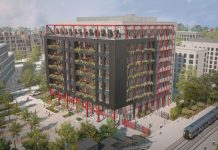Akshay Khera, architecture director at global design practice BDP, who is based in Bristol, says new EPC regulations for commercial buildings provide the opportunity to make wider workplace improvements.
With Energy Performance Certificate (EPC) regulations for commercial premises in England and Wales set to be extended from April this year, with further legal obligations coming down the pipeline in 2027, landlords need to act swiftly to understand the implications on their property portfolios, the work required, the timescales and cost implications. Occupiers too need to review the space they are leasing to check it meets the new standards to consider any forthcoming disruption any upgrades might cause and whether they have a lease break. However, with great challenge comes great opportunity; indeed, the looming EPC deadlines provide the chance for landlords and occupiers to review whether their current space is fit-for-purpose beyond what’s needed to meet EPC standards.
It is some of the existing building stock that’s likely to see the biggest knock-on impact. Refurbishing and retrofitting will be required to achieve compliance, otherwise they will no longer be able to be legally let to occupiers and landlords could face significant fines. In cities like Bristol, this comes against a backdrop of an overall lack of quality office space. According to Savills, total supply stood at 850,000 sq ft at the end of 2022, including 210,000 of Grade A office supply, meaning that there is just one-and-a-half years of supply in the market based on average demand.
According to current government regulations, an EPC is required for all commercial premises, with some exemptions, and they must achieve at least an E rating, within the A-G range, for new or renewal leases to be granted. The EPC looks at the building’s energy efficiency and is a measure of carbon emissions resulting from the day-to-day running of the building, known as operational carbon. In April 2023, this will extend to include not only new or renewing leases but existing leases as well. Looking further ahead, the Government is seeking to increase the minimum requirement to a B rating in 2030, with an interim requirement of a C rating in 2027.
The big wins when it comes to improving a building’s EPC tend to come from the upgrading of its fabric and systems. This could include improving the insulation, replacing the façade and/or glazing, upgrading the building’s mechanical and electric (M&E) equipment moving to all electric and switching to LED lighting – the extent of the upgrades depends on whether a light or deep retrofit is needed. For occupiers there are numerous benefits, not least potential savings on energy expenditure and improved indoor comfort. It is important to identify that it might not be possible for all buildings to go through an upgrade to the facade due to conservation requirements. Internal insulation could be added to improve thermal performance; however, this could present some technical challenges depending on the building fabric.
Enhancements can be achieved through parallel constructions activities, if the work required to upgrade building stock to meet EPC regulations is considered in tandem with upgrading workplace design related to improving staff wellbeing and working environments. This is a chance to adapt to evolving requirements such as hybrid and more flexible working, where occupiers are increasingly trading their office space for smaller but higher quality spaces. The traditional model of desk farms has changed to one of collaborative working zones and agile working. Employers are also taking seriously the importance of creating a workplace that’s truly inclusive, enabling everyone to thrive by developing spaces that promote equity, participation, and wellbeing, respecting and meeting the needs of people of all ages, races, cultures, identities, and abilities.
Sustainability is of course paramount, but not just due to looming deadlines to improve offices’ EPCs, but because employers recognise that they need to reflect the shared values of their staff, fostering a sense of purpose and belonging. Existing buildings sometimes provide a background story, sense of authenticity, and points of difference, which can be enhanced to create new quirky workplaces with true character and personality. This is the approach we are taking at the University of Bristol Dental School, a major retrofit project taking place in a former office, where the design features a biophilic (natural) wall in the atrium with social spaces to facilitate interaction along with upgrades to the M&E equipment to improve efficiency from a sustainability perspective. It’s worth keeping in mind that not all buildings can be upgraded to become a Grade A standard workplace; however, there are many other retrofit opportunities that can be explored for educational, healthcare or other uses.
Of course, each building needs to be considered on an individual basis, but there’s certainly an opportunity here not just for more energy efficient commercial spaces, but for ones that are highly desirable, user-centric, quirky and future-fit. We will be missing a trick if we don’t take a holistic approach towards improvements. Landlords, tenants, agents, facility managers and designers will need to work collaboratively to realise the full potential, both from a perspective of sustainability and enhancing the workplace environment.



















